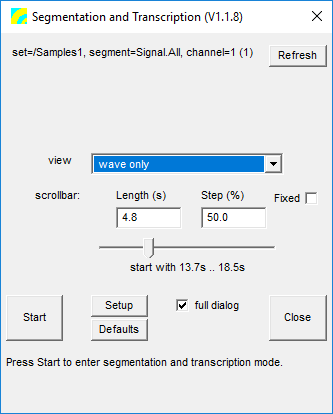Transcription Script
The 'Transcription' script is a tool in STx specifically written for transcribing signals. You will find it in the bottom left-hand corner of the Workspace where it is called Transcription.
When starting the Transcription script, you must select the segment in the Workspace you wish to transcribe. The following dialog will then appear.
Here you have the choice to choose which 'view' you would like.
- wave overview & spg. section
- A waveform overview of the whole selected segment and a spectrogram graph of a section of the overview.
- wave only
- Displays a waveform plot of a section of the selected segment, with the possibility to 'scroll' through the segment. The length of the displayed signal is defined the the 'scrollbar Length'.
- wave & spg. section
- Displays both a waveform and a spectrogram plot of a section of the selected segment. As with the 'wave only' view, the section length is defined by the 'scrollbar Length'.
Contents
Views
wave overview & spg. section
This view displays a waveform of the whole file and a spectrogram of a section of that file. This means that you can see all the segments in the file in the waveform graph. Navigating around the file in the waveform, you can then view a section of it as a spectrogram (e.g. with the hotkey 'S').
F0 / Formant Extraction
You can display the F0 and formants in the spectrogram by pressing the ![]() button. The settings for extraction are in the User Guide/SPExL/F0_Formant_Extraction_Settings dialog reached by pressing the button
button. The settings for extraction are in the User Guide/SPExL/F0_Formant_Extraction_Settings dialog reached by pressing the button ![]() .
.
Settings
There are many aspects of SPExL that you can change via the Settings dialog reached by the 'main' ![]() button, or the 'settings->setup dialog' context menu.
button, or the 'settings->setup dialog' context menu.
SPExL Hotkeys
Note that unless otherwise specified (e.g. with 'Shift'), all hotkeys are lowercase.
Analyze Hotkeys
| Ctrl+N | Select a viewer and profile to analyze the signal between the cursors with (opens new window). |
| Ctrl+A | Analyze the signal between the cursors with the viewer/profile which was used last. |
Cursor Hotkeys
| B | Move the cursors to the selected segment. |
| D | Move left cursor to the left. |
| F | Move left cursor to the right. |
| E | Move left cursor to the left in large steps. |
| R | Move left cursor to the right in large steps. |
| J | Move right cursor to the left. |
| K | Move right cursor to the right. |
| U | Move right cursor to left in large steps. |
| I | Move right cursor to right in large steps. |
| L | Flip left cursor around right cursor. |
| Shift + L | Flip right cursor around left cursor. |
Playback Hotkeys
| Escape | Stops playback |
| Space | Play between the cursors |
| A | Play all of signal in waveform window |
| O | Play all of the signal from the right-hand cursor to end of waveform window |
| P | Play the selected segment |
| W | Play all of signal up to the left-hand cursor |
Scrollbar Hotkeys
The length scrolled is defined when SPExL starts up (Scrollbar Step (%)).
| Ctrl + G | Jump top a position specified in seconds |
| M | Scroll forward |
| N | Scroll backwards |
Segment Hotkeys
| Shift + B | Move the selected segment to the cursor positions. |
| Enter | Create new segment between the cursors. |
Segment List Hotkeys
| Ctrl + R | Open the segment list sort order dialog. |
Spectrogram Hotkeys
| Shift + Add | Increase amplitude floor. |
| Shift + Subtract | Decrease amplitude floor. |
Zoom Hotkeys
| Y | Zoom in on the x axis around the mid point between the cursors. |
| Q | Zoom out on the x axis around the mid point between the cursors. |
| Ctrl + Add | Zoom in on the y axis around the active cursor |
| Ctrl + Subtract | Zoom out on the y axis around the active cursor |
| V | Zoom between cursors on the x axis |
| Shift + V | Zoom between cursors on the y axis. Note that this only works if the cursor style allows y axis positioning. |
| G | Zoom in around the left-hand cursor. |
| T | Zoom out around the left-hand cursor. |
| H | Zoom in around the right-hand cursor. |
| Z | Zoom out around the right-hand cursor. |
| X | Reset the zoom |

